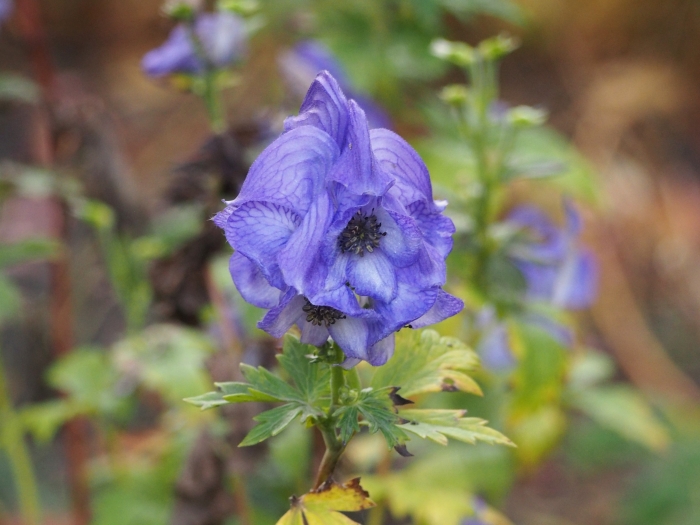Carmichael’s Monkshood
(Aconitum carmichaeli)
Carmichael’s Monkshood (Aconitum carmichaeli)
/
/

Agnieszka Kwiecień, Nova
CC BY-SA 4.0
Image By:
Agnieszka Kwiecień, Nova
Recorded By:
Copyright:
CC BY-SA 4.0
Copyright Notice:
Photo by: Agnieszka Kwiecień, Nova | License Type: CC BY-SA 4.0 | License URL: https://creativecommons.org/licenses/by-sa/4.0 | Uploader: Nova | Publisher: Wikimedia Commons | Title: Aconitum_carmichaelii_Tojad_Carmichaela_2023-10-30_04.jpg | Notes: == {{int:filedesc}} == {{Information |Description=Muskingum Sedge, Swamp Oval Sedge (Carex muskingumensis) along Meadow Lake Morton Arboretum |Source=[https://www.flickr.com/photos/50352333@N06/4774777960/ Muskingum Sedge, Sw


















Estimated Native Range
Summary
Aconitum carmichaeli, commonly known as Carmichael’s Monkshood, is a deciduous perennial herb that is native to moist meadows and stream banks in East Asia, particularly in China. It typically grows up to 1.2 meters (4 ft) tall and 30 centimeters (12 in) wide. This plant features dense panicles of deep azure to violet-blue flowers, which bloom in late summer and autumn, adding a vibrant splash of color to the garden. The foliage is deeply divided, giving it a fine texture. Carmichael’s Monkshood is known for its striking flowers and is often used in borders and woodland gardens.
Carmichael’s Monkshood is appreciated for its showy flowers and vertical form, which make it a focal point in the garden. It is also used for cut flowers due to its tall flower spikes. This plant prefers consistently moist, fertile soil and can tolerate part shade, making it suitable for planting under deciduous trees. While it can grow in full sun, it requires sufficient moisture to prevent wilting. It is important to handle this plant with care, as all parts are extremely toxic if ingested. Gloves should be worn when planting or dividing, as the toxins can be absorbed through the skin. The cultivars ’Arendsii’ and ’Kelmscott’ (Wilsonii Group) have been awarded the Royal Horticultural Society’s Award of Garden Merit for their outstanding qualities.CC BY-SA 4.0
Carmichael’s Monkshood is appreciated for its showy flowers and vertical form, which make it a focal point in the garden. It is also used for cut flowers due to its tall flower spikes. This plant prefers consistently moist, fertile soil and can tolerate part shade, making it suitable for planting under deciduous trees. While it can grow in full sun, it requires sufficient moisture to prevent wilting. It is important to handle this plant with care, as all parts are extremely toxic if ingested. Gloves should be worn when planting or dividing, as the toxins can be absorbed through the skin. The cultivars ’Arendsii’ and ’Kelmscott’ (Wilsonii Group) have been awarded the Royal Horticultural Society’s Award of Garden Merit for their outstanding qualities.CC BY-SA 4.0
Plant Description
- Plant Type: Herb
- Height: 2-3 feet
- Width: 1.5-2.5 feet
- Growth Rate: Moderate
- Flower Color: Purple, Blue
- Flowering Season: Summer, Fall
- Leaf Retention: Deciduous
Growth Requirements
- Sun: Full Sun, Part Shade
- Water: Medium
- Drainage: Slow, Medium, Fast
Common Uses
Bee Garden, Bird Garden, Butterfly Garden, Deer Resistant, Hummingbird Garden, Rabbit Resistant, Salt Tolerant, Showy Flowers
Natural Habitat
Moist meadows and stream banks in East Asia, particularly in China
Other Names
Common Names: Sichuan Aconite, Chinese Wolfsbane, Chinese Aconite, Japanese Aconite, Oktoberstormhatt, Fu Zi, Chuan Wu
Scientific Names: , Aconitum carmichaeli, Aconitum carmichaeli var. wilsonii, Aconitum wilsonii, Aconitum lushanense, Aconitum bodinieri, Aconitum carmichaeli subsp. wilsonii, Aconitum kusnezoffii var. bodinieri,
GBIF Accepted Name: Aconitum carmichaeli Debeaux